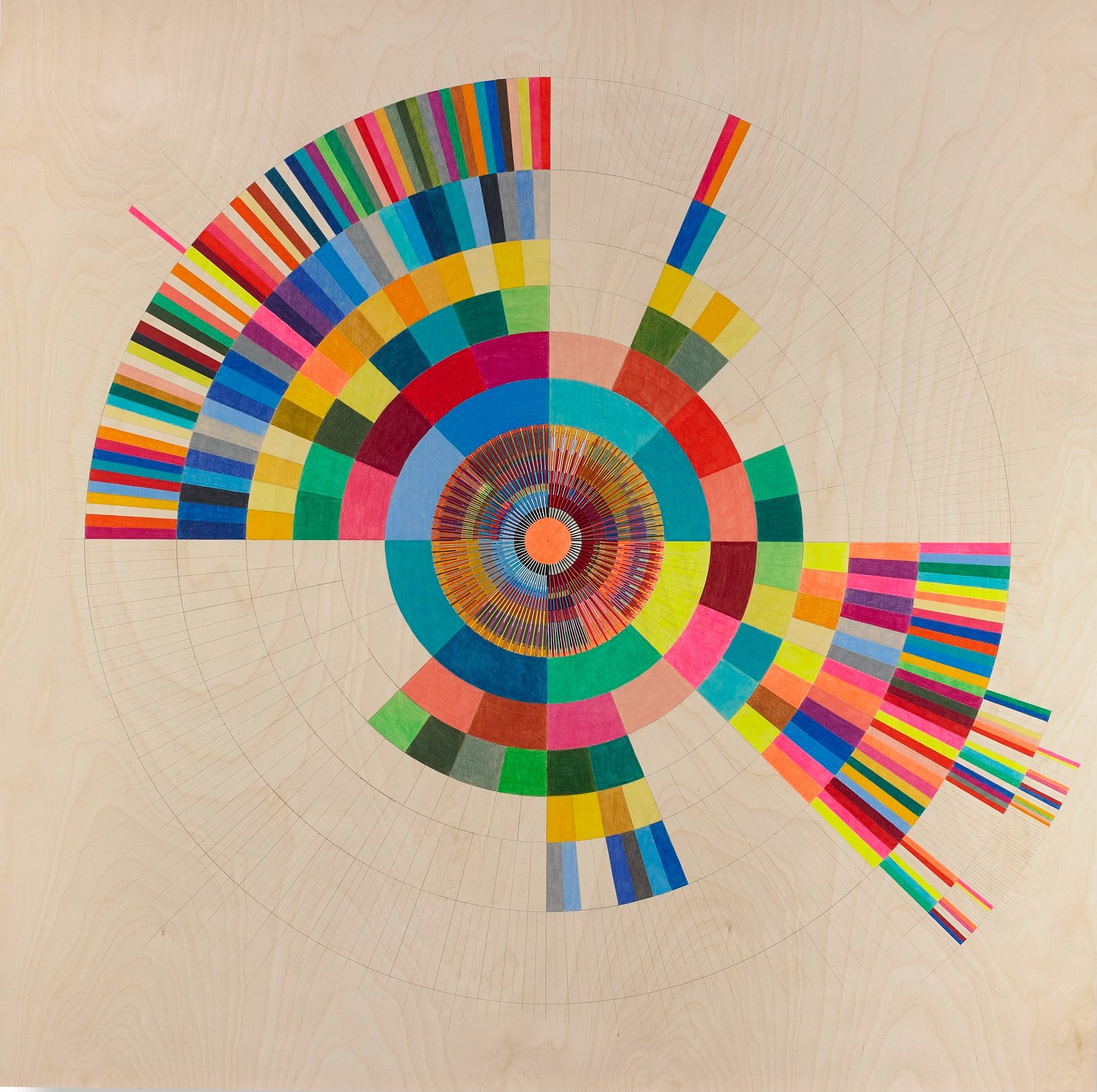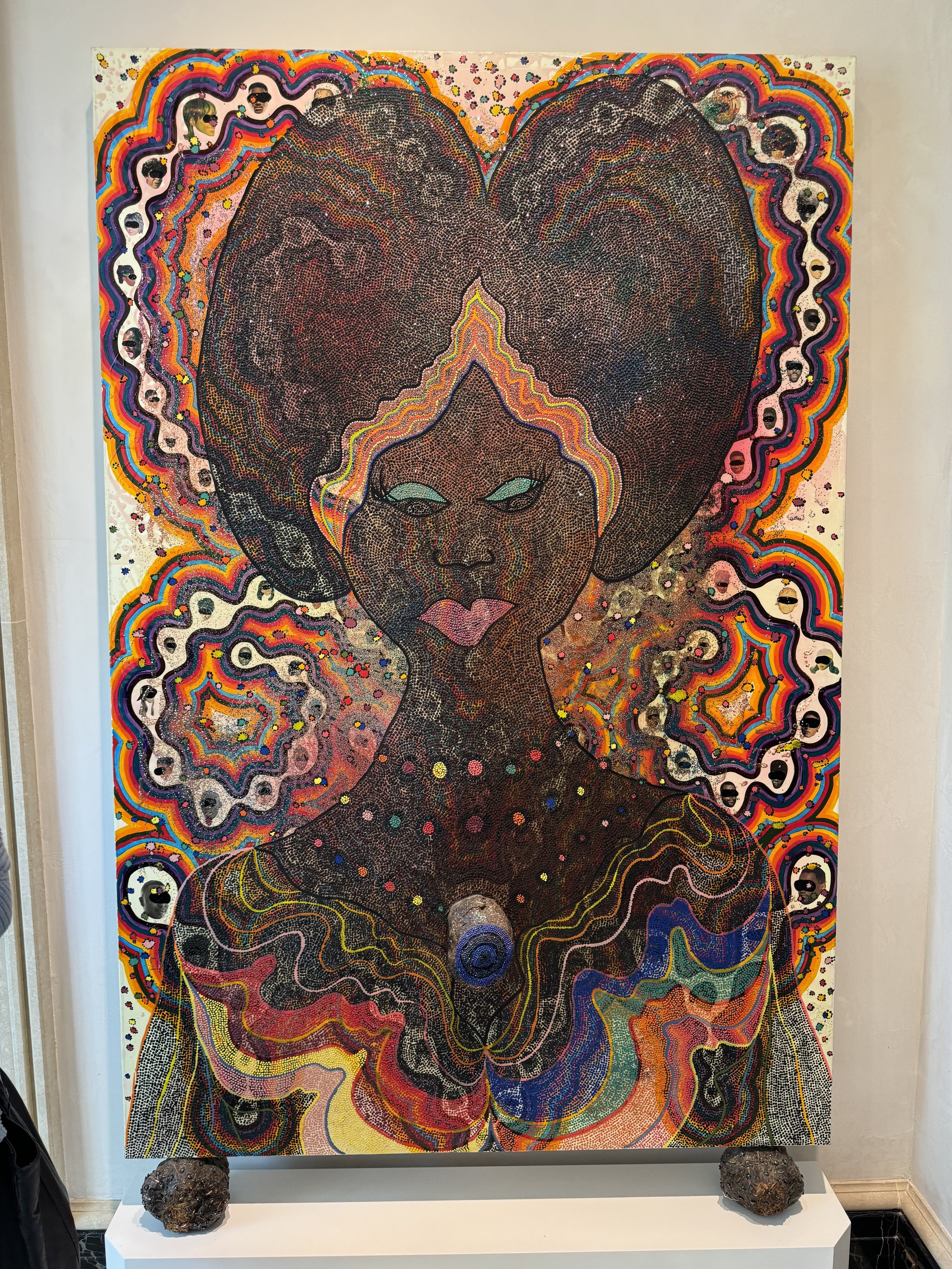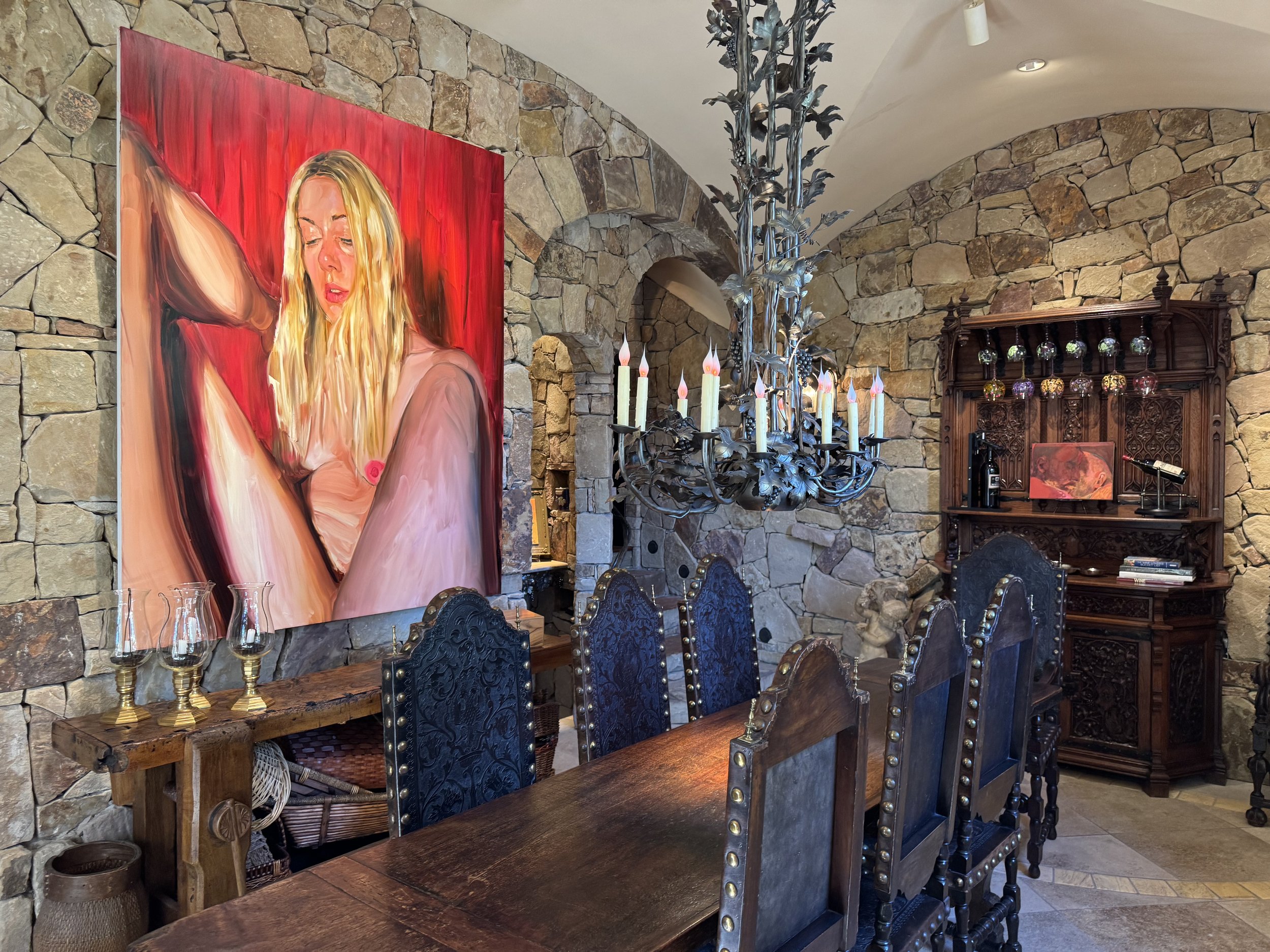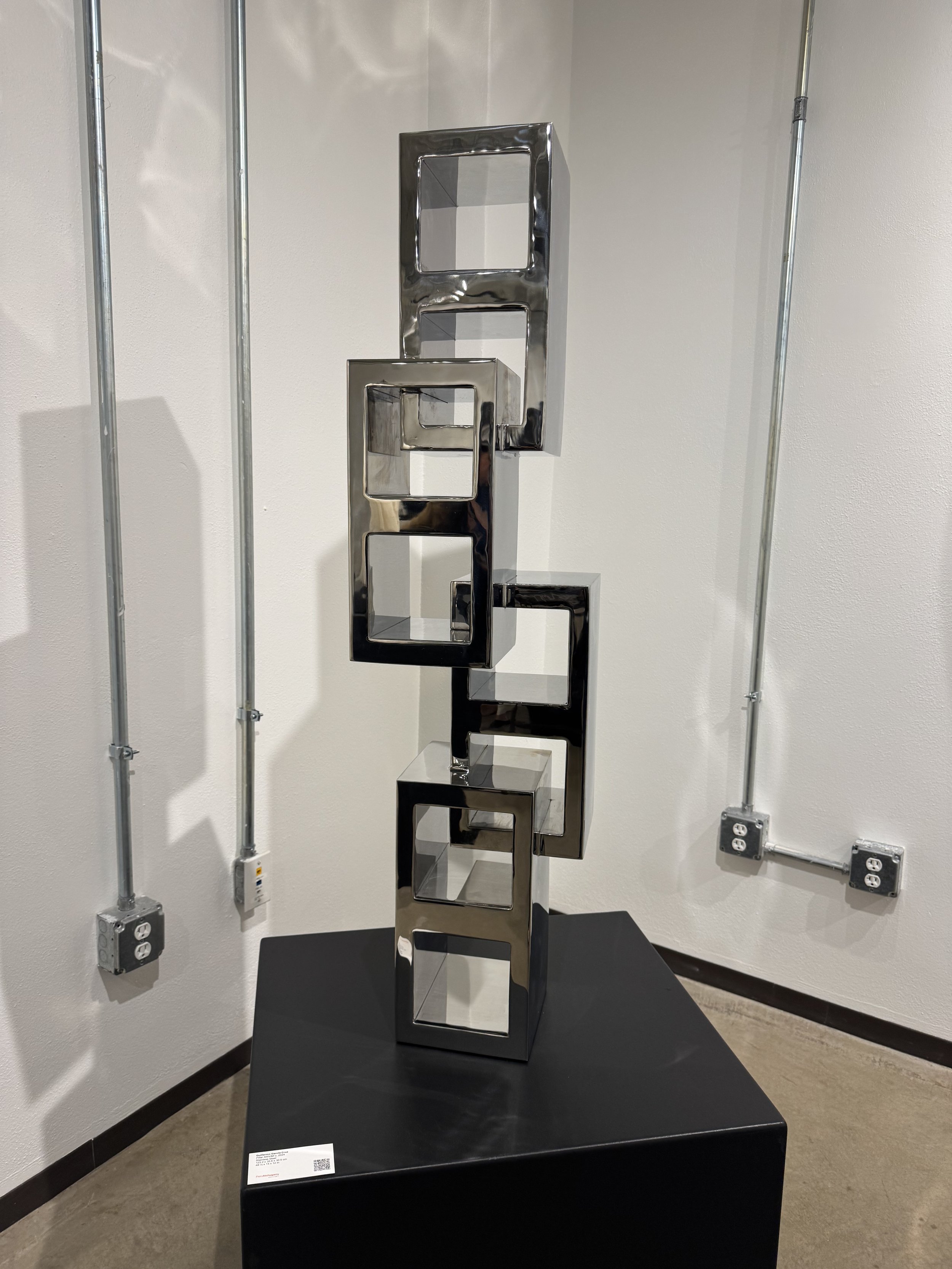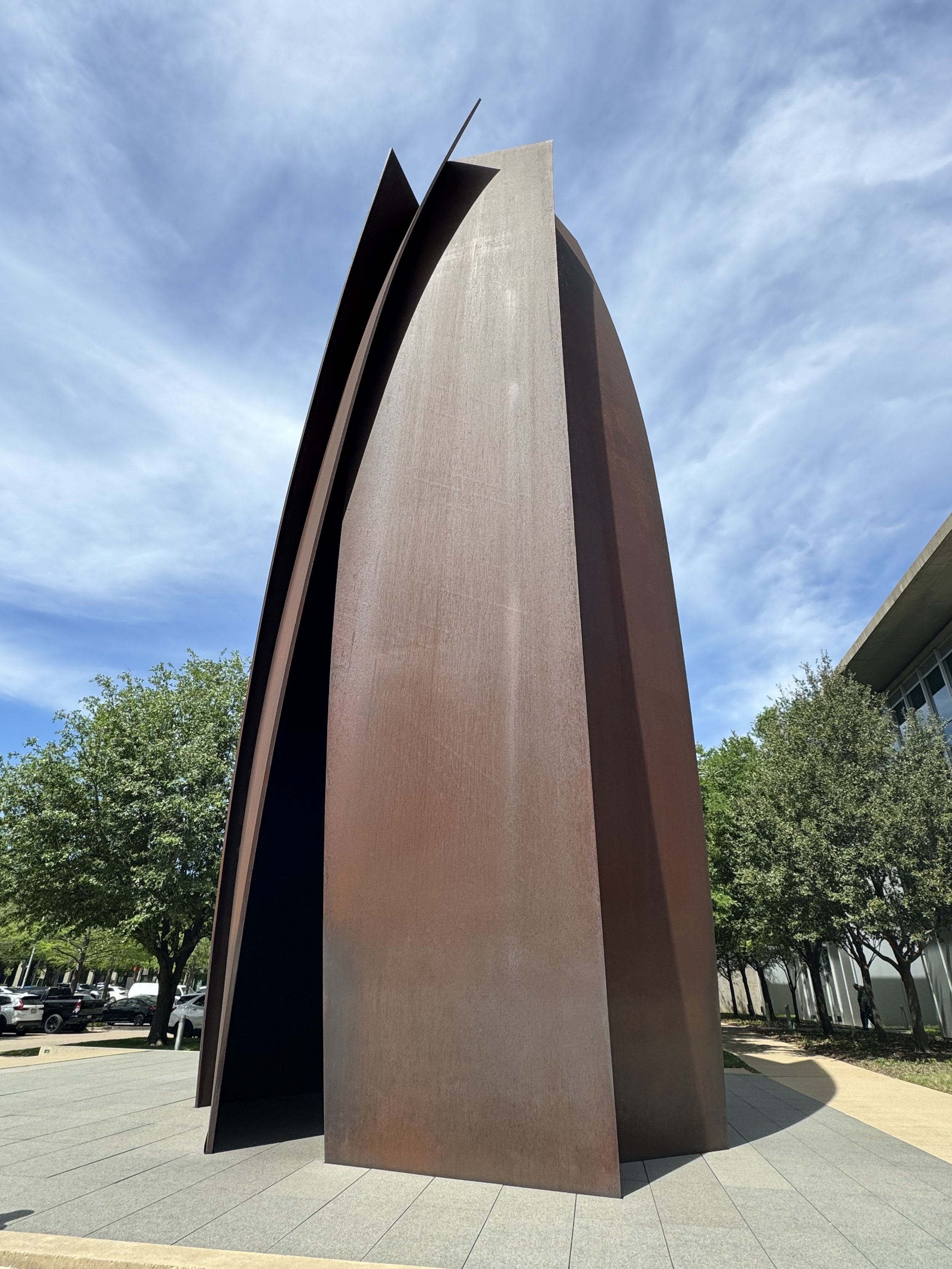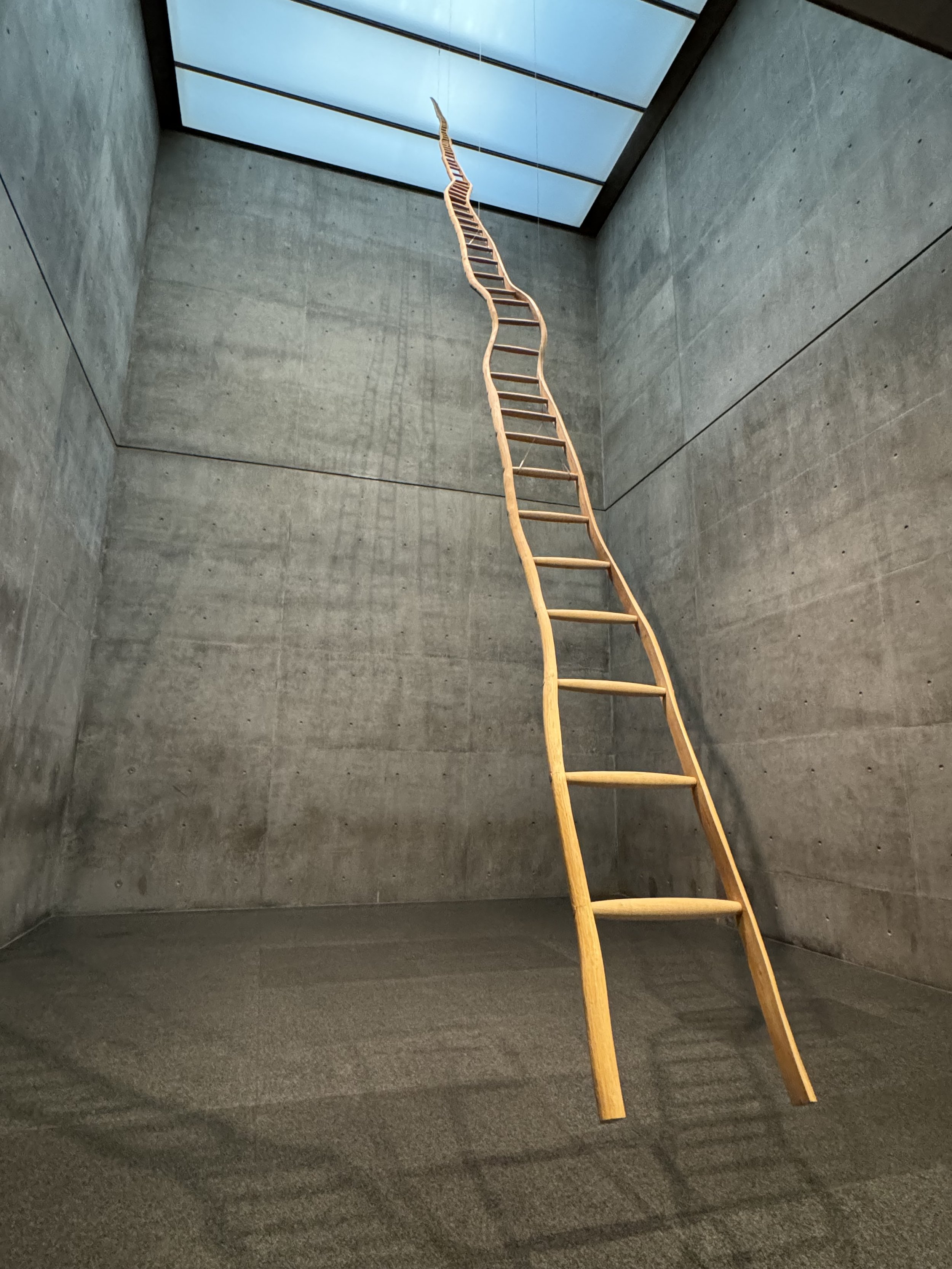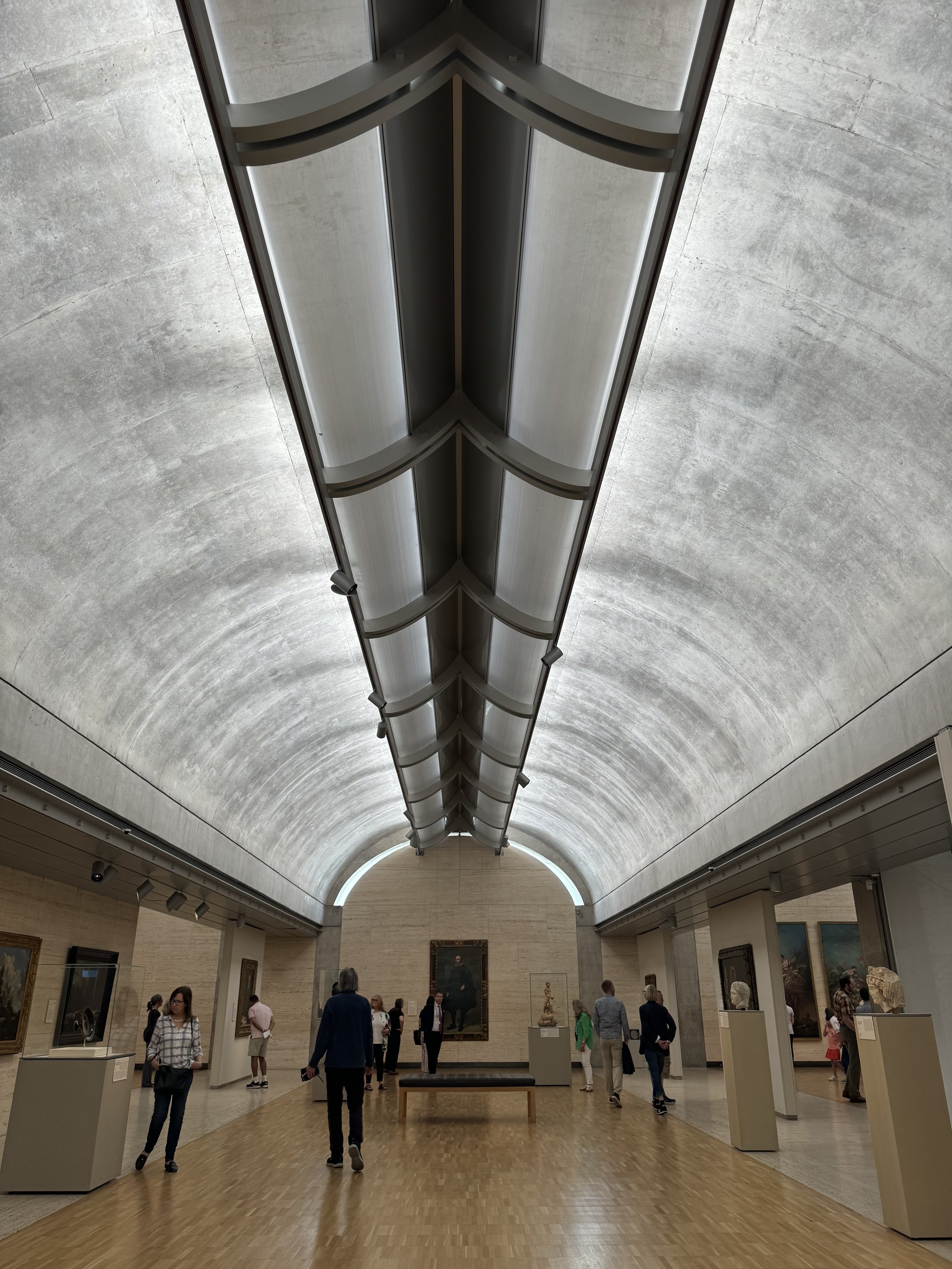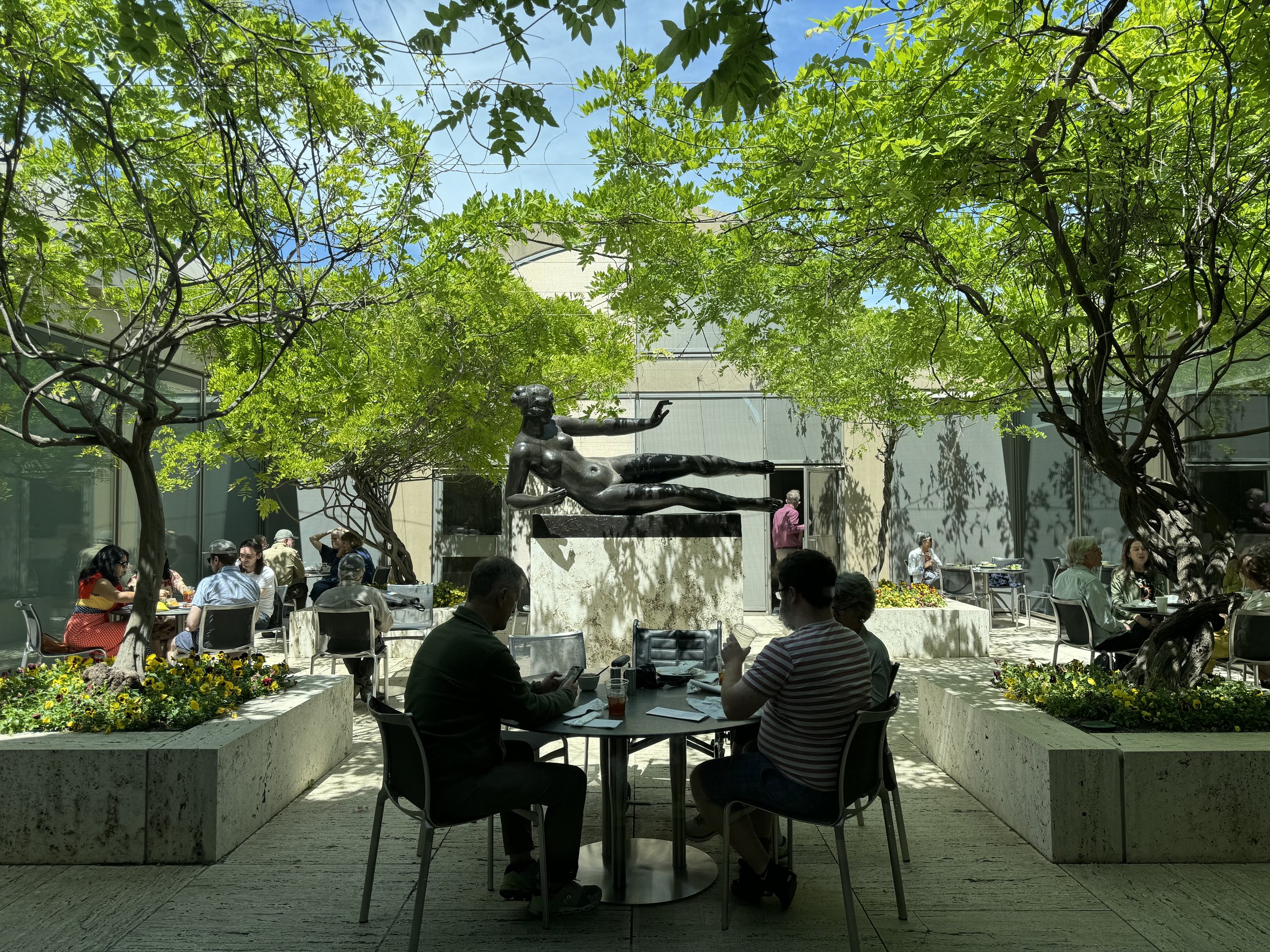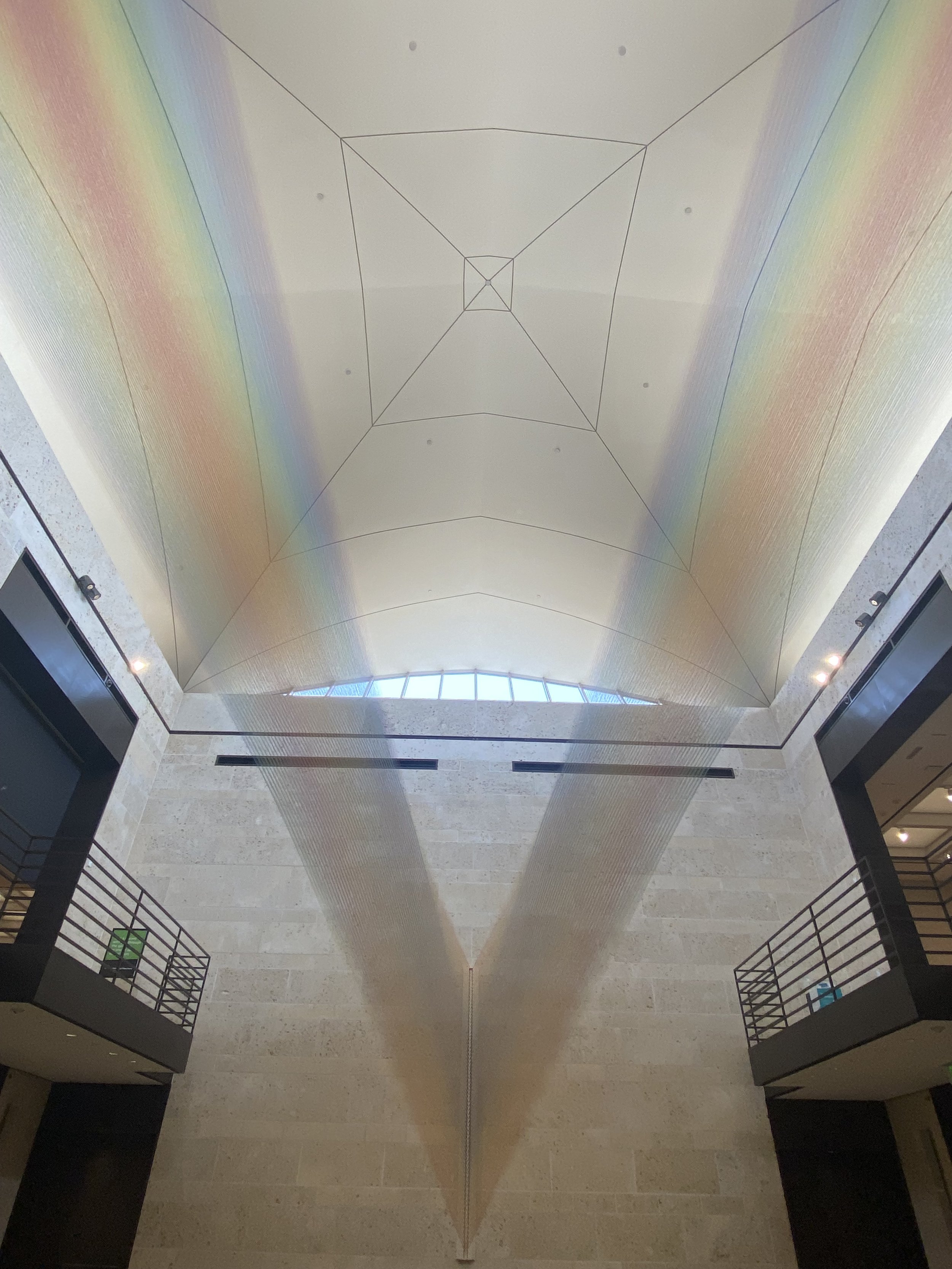Art’s Virtuous Cycle of Engagement
Operating confidently, as Charting Transcendence does, in an ecosystem built around discrete objects of wonder created for their own sake is more of an art than a science.
Advisors, after all, build relationships by engaging with art, artists, and professionals of varying degrees of familiarity and approachability.
Having committed to this line of work, one thing I recently internalized is that true engagement with art inevitably begets connection, from which all feelings or affect (the experience of emotions) begins to flourish in abundance.
Tia Keobounpheng (b. 1977), whose rising star as an emerging artist Charting Transcendence has been following since 2023, has embarked on a new direction in charting the lines and threads of her own identity with Circle Round No. 8 (2025), pencil, colored pencil, thread on wood, 48” x 48.” This masterful geometrically abstract artwork will be shown by Weinstein Hammons Gallery at EXPO Chicago, April 24-27, 2025.
Because collecting art is a discretionary purchase available to those relatively privileged enough to afford, CT structures the client’s approach to their journey based on the connection we form together, ultimately choosing their acquisition based on intelligence and gut sense of how, together, we approach market’s idiosyncratic attention economy.
At the end of the day, this engagement with art and its marketplace reinforces a virtual cycle of passion and connection, which nourishes my own talent for mapping out this ecosystem outwards, while keeping what matters at the heart of the search.
I believe in my vision and my superpower — Charting Transcendence — as a modus operandi for discovery, and growth, which, when set into motion, constantly gives back, generating new ideas and positive feelings that become works of art in themselves.
A Sprawling Metroplex’s Abundant Potential for Art
Try to imagine the contemporary art scene of the country’s fourth largest metropolitan statistical area as if it were like that of Southern California 50 years ago (think unpretentious and spacious), transpose it to the vast plains of North Texas, then give it a Cowboy-strength dose of ambition and culture.
Wait a decade or two, and you’ll clearly have a major world cultural capital for the remainder of the 21st century.
As Texas’s cities continue to grow and evolve in diversity and sophistication, building relationships around their art scenes has been a priority for Charting Transcendence from the beginning.
Dallas Art Week Highlights
My favorite event this year — same as last year — was an open house at a palatial Dallas mansion, the primary residence of the most ambitious and sophisticated collectors in the city.
The Green Family has a massive budget and rich appetite for the kind of art that really turns heads today, including Black and queer artists who reflect the increasing level of complexity, diversity, and inclusivity of contemporary American society.
The family regularly rotates over 250 “to die for” original artworks throughout their chateauesque expanse of over 30 rooms and corridors — and they have plenty more to choose from in storage and in their own private museum downtown.
Dallas’s Green Family owns several works by British artist Chris Ofili (b. 1968), including Blind Eyes Shining Back (1999), oil, acrylic, paper collage, glitter, polyester resin, map pins, and elephant dung on canvas (yes — elephant dung is what made Ofili famous.)
A late work by Barkley Hendricks (1945-2017), Passion Dancehall #1 (2011), who over decades built his reputation a master of black figuration and portraiture, in the Green Family’s collection.
Even the wine cellar is bedecked with jaw-dropping works by contemporary LGBTQ artists, including this female nude, Red curtain stagescape (2021) by Jenna Gribbon (b. 1978).
Coolieisms, aka: Leather Daddy’s Highbinder Odalisque (2022) by Oscar yi Hou (b. 1998), a breakout star among young LGBTQ artists, in the Green Family’s collection.
Several satisfying exhibitions were on display in Dallas’s museums, many of which follow a model already popular in Miami, whereby local collectors — as a tax write-off or an act of philanthropy or both — have made their art-filled warehouse spaces accessible to the public.
The Dallas Museum of Art, although slated for an expansion in the coming years, has suffered from budget cuts, so that relatively few of the exhibitions on display had much art that had turned over since my previous visit last year.
Fortunately, downtown Dallas’s Arts District has several other great museums within walking distance, including the Nasher Sculpture Center, the Crow Museum of Asian Art (part of the University of Texas at Dallas), and, of course, the Green F,amily Art Foundation. At least a half dozen other good venues and museums can be found in other parts of town.
The Dallas Contemporary opened a show last week called You Stretched Diagonally Across It: Contemporary Tapestry as an admirable attempt to survey the wide breadth of fiber-based art being created today. My favorite piece was Motherboard Vibrations (2024) by Navajo artist Melissa Cody (b. 1983).
The privately-owned Karpidas Collection put on a museum-quality show of highly sought after paintings by George Condo (b. 1957). Condo’s unique style of figuration is evocative of Picasso’s and is unmistakably recognizable to art patrons and connoisseurs.
The Warehouse, a non-profit contemporary art museum sponsored by the Rachofsky Collection, is currently showing a trove of abstract painting, including this marvelous piece by superstar artist Anicka Yi (b. 1971).
Recently closed after a one-year run, the Dallas Museum of Art’s show When You See Me: Visibility in Contemporary Art/History featured works pulled from the diverse range of contemporary artists in their collection, including this complex piece by Bahamian artist Tavares Strachan (b. 1979).
Highlights from 2025 Dallas Art Fairs
One nice surprise at the upstart and high-end Dallas Invitational fair, held at the Rosewood Mansion luxury hotel, was this piece by Dutch artist Michael Raedecker (b. 1963), demo (living end) (2025), laser printer pigment transfer, dispersion, acrylic & thread on canvas.
Tribeca’s JDJ Gallery showed lovely geometrically abstract paintings with hints of the 20th century’s Transcendental Painting School by Australian-born, NYC-based artist Minako Iwamura (b. 1967).
Brooklyn’s Carvalho Park Gallery sold Rachel Mica Weiss’s (b. 1986) Solar Flare (2025), polyester embroidery thread, brass hooks, maple, at the Dallas Art Fair for around $25,000.
Miami’s Piero Atchugarry Gallery was at the Dallas Art Fair, showing sculpture by Uruguayan artist Guillermo Garcia Cruz (b. 1988), which some will recognize from the Meridian section of Art Basel Miami Beach 2024.
The Best Triple Set of Art Museums in the USA
Having surpassed Austin as the fourth most populated city in Texas, fast-growing Fort Worth (pop. 2025: 1,015,045) is an unassuming, laid-back town that nevertheless has had a long connection to the arts, (including its own movement — the Fort Worth Circle) thanks in no small part to the city’s tycoons having grown rich over a century ago off of oil, cattle, and industry.
Nowhere else in the USA can I imagine three more complementary yet distinct museums nestled right next to each other than the Modern Art Museum of Fort Worth, the Kimbell Art Museum, and the Amon Carter Museum of American Art.
Covering all three is possible (and well worth the time spent) in a single day. Not only is the art outstanding, but each of their buildings were designed by A-list architects, giving the entire experience a gesamtkunstwerk feeling.
Outside the entrance to the Tadao Ando (b. 1941) designed Modern Art Museum of Fort Worth (a.k.a. “The Modern”) sits Vortex (2002), one of my top three favorite sculptures of all time by Richard Serra (1937-2024). This sculpture, which you can enter, reaches a height of 68 feet.
African-American artist Martin Puryear (b. 1941), who represented the U.S. at the Venice Biennale in 2019, has his sculpture Ladder for Booker T. Washington (1996) on permanent display in a dedicated gallery inside The Modern where it can be viewed from many angles.
The Modern puts on mind-blowing contemporary art exhibitions, often in conjunction with major institutions in New York, LA or Europe, while co-curating other parts of its building with some gems of post-war art, such as this abstract expressionist painting by Dan Christensen (1942-2007).
The vaulted-barrel ceilings of the exquisite Kimbell Art Museum that softly deflect the harsh Texas sun are a pinnacle achievement of the architectural genius Louis I. Kahn (1901-1970). The Kimbell’s collection focuses on older masterworks, modern art, as well as treasures of Asian and non-Western art.
The loveliest spot to have lunch for under $20 in Fort Worth might just be the courtyard of the Kimbell Art Museum which is graced by the presence of a magnificent bronze sculpture by French modern sculptor Aristide Maillol (1866-1944).
Beguiling the viewer is this treasure of the Kimbell’s modern art collection, L’Asie (1946), a late painting by Henri Matisse (1969-1954), personifies the world’s largest continent as an elegant woman.
Fort Worth’s Amon Carter Museum was founded as a Western art museum but has evolved into a much more. Its core body of work by Frederic Remington (1861-1909), who depicted the characters of the waning days of the American frontier, was massively influential in shaping American West — think “cowboys and Indians” — stereotypes that persist to this day without accurately the region’s diversity and complexities.
The Amon Carter is one of several museums in the United States I can think of that is lucky enough to have a work in its atrium by Gabriel Dawe (b. 1973), a contemporary American artist who constructs spatial sculptures out of colorful threads.
Some Early Spring Art Highlights from NYC
There will be so much art to see over the next month or two in New York City, including Frieze New York and several outstanding satellite fairs — please reply to this email for details!
Myrlande Constant (b. 1968) is a Haitian artist who has gained significant recognition. Her show at the Meatpacking District’s Fort Gansevoort gallery features intricated embroidered Haitian ceremonial flags known as drapo vodou.
Art advisors I know have been raving about a new series of paintings by Scottish artist Caroline Walker (b. 1982), which depict women who work at holiday parks, at GRIMM Gallery in Tribeca.
One of New York’s top museum shows is a MoMA-mounted full-career retrospective mounted by MoMA of African-American artist Jack Whitten (1939-2018) who continuously innovated techniques in painting. This mosaic-like work is constructed out of cubes of dried acrylic paint called tesserae.
One of the best gallery shows I saw this month was at Clearing on New York City’s Bowery: large, luscious dreamscape paintings by Robert Zehnder (b. 1992) on view until April 26.


